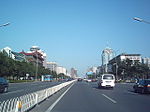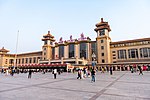Office of the Macau Special Administrative Region in Beijing
China stubsGovernment buildings in ChinaMacau Economic and Trade OfficeMacau stubs

The Office of the Macau Special Administrative Region in Beijing (simplified Chinese: 澳门特别行政区驻北京办事处; traditional Chinese: 澳門特別行政區駐北京辦事處; pinyin: Àomén Tèbié Xíngzhèngqū Zhù Běijīng Bànshìchù; Portuguese: Delegação da Região Administrativa Especial de Macau em Pequim) is the representative office of Macau in the mainland area of the People's Republic of China. Its counterpart office is the Liaison Office of the Central People's Government in the Macao Special Administrative Region, representative office of the Central Government of the People's Republic of China in Macau.
Excerpt from the Wikipedia article Office of the Macau Special Administrative Region in Beijing (License: CC BY-SA 3.0, Authors, Images).Office of the Macau Special Administrative Region in Beijing
North Jianguomen Str, Beijing Jianguomen
Geographical coordinates (GPS) Address Nearby Places Show on map
Geographical coordinates (GPS)
| Latitude | Longitude |
|---|---|
| N 39.911666666667 ° | E 116.42777777778 ° |
Address
华润大厦
North Jianguomen Str 8号
100005 Beijing, Jianguomen
Beijing, China
Open on Google Maps









